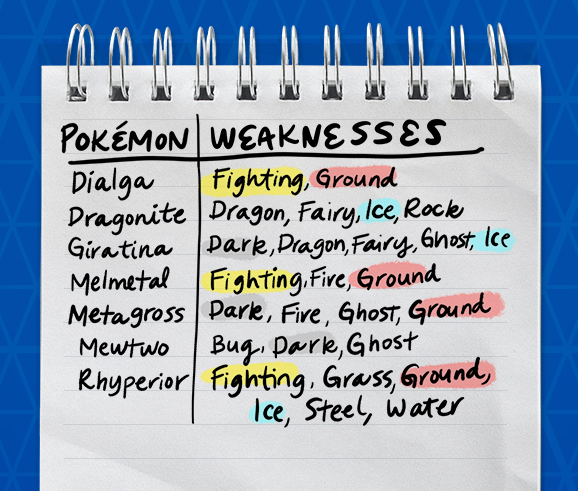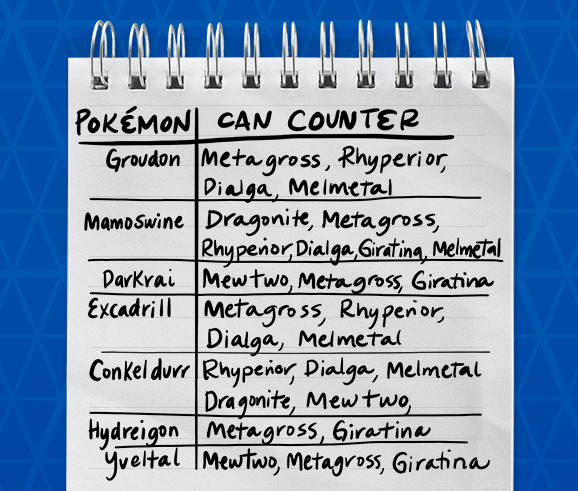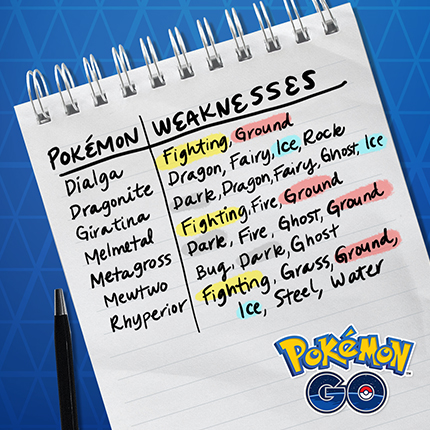Balance, count, and plan your way to victory in the Great League, Ultra League, and Master League.
Mastering the Pokémon GO Battle League isn’t as easy as one,
two, three, but you might be surprised by how far a little counting can get
you. Now that you’ve learned how
to get started in the GO Battle League and to use
Charged Attacks and Fast Attacks effectively,
it’s time to explore more advanced techniques. From balancing energy per second
and damage per second to counting your opponents’ Fast Attacks, there’s a lot
you can do to sharpen your strategy.
Choosing a Fast Attack might seem simple: pick the Fast
Attack that deals the most damage per second (DPS)
and start battling, right? However, it’s important to note that Fast Attacks also
generate energy to power up your Charged Attacks. A Fast Attack that generates
more energy per second (EPS)
will allow you to utilize your Charged Attacks more quickly. Many Fast Attacks deal high DPS but generate low EPS, and vice versa, so
it’s important to find the right balance between the two.
For example, Swampert is an extremely popular Pokémon in the
GO Battle League, finding success at all levels. It has two available Fast
Attacks: Mud Shot and Water Gun. At first glance, it seems that the attacks are
mostly the same, each dealing 5 damage. However, Water Gun deals slightly higher
DPS while Mud Shot generates slightly higher EPS. So
it’s not just a question of whether you want a Water-type attack or Ground-type
attack, but also whether you want to focus on dealing damage or powering up
Charged Attacks.
There are plenty of factors to consider when balancing
between DPS and EPS, such as attack types and the order of Pokémon on your team.
For example, it might make sense for your lead Pokémon to use a Fast Attack
with high EPS, allowing it to use Charged Attacks as quickly as possible to get
your opponent to use up their Protect Shields.
When comparing two Fast Attacks with differing DPS and EPS, it’s
important to note how big the difference is. If the DPS for one Fast Attack is
substantially higher while the EPS is only marginally lower, it might be worth
choosing it over the other attack. Ultimately, whichever Fast Attacks you
choose need to complement your broader strategy, but understanding the roles that
DPS and EPS play is vital to success in the GO Battle League.
Counting your opponent’s Fast Attacks will allow you to make
more educated decisions about when to use a Protect Shield, when to switch out
your Pokémon, and when to use your own Charged Attacks.
Each Fast Attack must be used a certain number of times to
charge up a Charged Attack. That number depends on how much EPS that Fast
Attack generates and how much energy a Charged Attack requires. You’ll also have
to consider the two Charged Attacks an opposing Pokémon could know and how many
attacks it takes for that Pokémon to charge them up. For example, Swampert commonly
uses the Fast Attack Mud Shot and the Charged Attacks Earthquake, Hydro Cannon,
and/or Sludge Wave. Swampert needs to use five Mud Shot attacks to power up
Hydro Cannon and eight to power up Earthquake and Sludge Wave. By counting the
number of Mud Shot attacks the opposing Swampert does, you could switch out
your Pokémon for one that will take less damage from one of these Charged
Attacks. As you continue to face off against different commonly used Pokémon in
the GO Battle League, try to note how many Fast Attacks they take to charge up
their Charged Attacks, allowing you to make better decisions on when to switch
Pokémon or use Protect Shields. This might seem like a lot of information to
memorize at first, but once you have experience in the GO Battle League, you’ll
quickly learn the paces of commonly used Pokémon. Don’t forget to pay attention
to how your own team’s timing works so you can apply it to your rivals!
Choosing Pokémon to include in your battle lineup is the
most important decision in GO Battle League. One effective way to start
building your dream team is to consider the Pokémon you’ll commonly face off
against in a given league.
While Pokémon GO’s tagging system does provide some
organizational structure, if you really want to get strategic, grab a pen and
paper or create a document or spreadsheet. You’re eventually going to need
three sets of lists—one for Great League, one for Ultra League, and one for
Master League—as the Pokémon you’re likely to face in each are different.
Your notes don’t have to be crazy detailed. Start simple! You
can begin by jotting down a list of the Pokémon you most frequently encounter
within a league. The more Pokémon you include on this list, the more information
you can use to make your team. Next, list out those Pokémon’s weaknesses. The
example list below includes some commonly used Pokémon in the Master League as
well as their weaknesses.

-
Dragonite
-
Weaknesses: Ice, Rock, Dragon, Fairy
-
-
Mewtwo
-
Metagross
-
Weaknesses: Fire, Ground, Ghost, Dark
-
-
Rhyperior
-
Weaknesses: Water, Grass, Ice, Fighting, Ground, Steel
-
-
Dialga
-
Giratina
-
Weaknesses: Ice, Ghost, Dragon, Dark, Fairy
-
-
Melmetal
Next, take note of which types that appear the most frequently on this list.
-
Ground: 4
-
Fighting: 3
-
Ice: 3
-
Dark: 3
Then, go through your Pokémon and find the ones that would
make the best counters to the Pokémon listed above. In this case, you’ll want
to focus on Pokémon that know Ground-, Fighting-, Ice-, and Dark-type attacks
and particularly Pokémon of those types. If you need to break ties,
prioritizing your higher CP Pokémon isn’t a bad idea. Here’s some commonly used
Pokémon in the Master League that match the type requirements in this example.

-
Groudon
-
Can Counter: Metagross, Rhyperior, Dialga, Melmetal
-
-
Mamoswine
-
Can Counter: Dragonite, Metagross, Rhyperior, Dialga, Giratina, Melmetal
-
-
Darkrai
-
Excadrill
-
Can Counter: Metagross, Rhyperior, Dialga, Melmetal
-
-
Conkeldurr
-
Hydreigon
-
Can Counter: Dragonite, Mewtwo, Metagross, Giratina
-
-
Yveltal
Then, choose three of these Pokémon that provide overall
coverage against the commonly used Pokémon listed earlier. For example,
Mamoswine, Excadrill, and Yveltal would be a good team that could counter all
of the listed Pokémon. As you encounter different Pokémon in the GO Battle
League, you can build on your list and modify your teams accordingly.
If you want to go even further, track your opponents’ lead
Pokémon and watch for patterns you can exploit. If most leads are Dragon-type
Pokémon, for example, lead with your best counter to Dragon-type Pokémon.
You can also keep the document handy if you’re still
memorizing type vulnerabilities and strengths. And as you transition between
Great League, Ultra League, and Master League, the document can be a nice
refresher about which Pokémon you used and why.
Most importantly, keep playing, keep learning, and keep having fun!

Source: Pokemon

